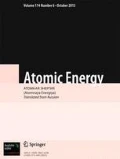Post-reactor investigations have been performed on BN-600 fuel-element cladding, made of 0Kh16N15M3BR steel, after irradiation to maximum burnup of 10% h.a. and higher. It is shown that the highest degradation of the operating properties of the fuel-element cladding is observed in the zone of maximum increase of its diameter and is expressed as total embrittlement of the cladding material and appearance of cracks of substantial depth on the inner surface. The processes resulting in the degradation of the properties of fuel-element cladding are directly related either with swelling or with radiation-induced segregation, occurring in the same temperature range and under the action of the same driving forces as swelling. The most important stresses, from the standpoint of the serviceability of fuel elements, turn out to be those arising in cladding as a result of the gradient of the swelling along the thickness of the cladding. The level of these stresses is also determined by the form of the temperature dependence of the swelling of the steel used for the fuel-element cladding.
Similar content being viewed by others
References
F. G. Reshetnikov, F. M. Mitenkov, and M. F. Troyanov, “Status and prospects for development in the USSR of radiation-resistant structural materials for fast-reactor cores,” At. Énerg., 70, No. 2, 104–107 (1991).
F. G. Reshetnikov, “Development of structural materials and problems of increasing FR fuel burn-up,” in: Proc. Intern. Conf. on Fast Reactors and Related Fuel Cycles, Kyoto, Japan (1991), Vol. 1, pp. 7.6-1–7.6-7.
S. E. Astashov, E. A. Kozmanov, A. N. Ogorodov, et al., “Shape change of the components of a BN-600 core,” At. Énerg., 75, No. 3, 167–175 (1993).
S. I. Porollo, A. N. Vorobyev, V. D. Dmitriev, et al., “Post-irradiation examination of the BN-600 pins,” in: Proc. Intern. Conf. on Fast Reactor Core and Fuel Structural Behavior, UK (1990), pp. 237–241.
V. S. Ageev, N. M. Mitrofanova, M. G. Bogolepov, et al., “Boron microalloying of 0Kh16N15M3B austenitic steel to increase its radiation-resistance,” in: Intern. Conf. on Radiation Materials Science, Alushta (1990), Vol. 3, 27–34.
V. S. Neustroev, V. N. Golovanov, and V. K. Shamardin, “Radiation embrittlement of fuel-assembly materials in the temperature range of maximum swelling,” At. Énerg., 69, No. 4, 223–226 (1990).
J. Straalsund and C. Day, “Effect of neutron irradiation on the elastic constants of type 304 stainless steel,” Nucl. Technol., 20, No. 1, 27–34 (1973).
R. Schramm and R. Reed, “Stacking fault energies of seven commercial austenitic stainless steels,” Metal. Trans., 6A, 1345–1351 (1975).
P. Okamoto and H. Wiedersich, “Segregation of alloying elements to free surfaces during irradiation,” J. Nucl. Mater., 53, 336–346 (1974).
E. Gudremon, Special Steels, Metallurgiya, Moscow (1966).
V. N. Bykov, V. D. Dmitriev, and S. I. Porollo, “Effect of silicon and nitrogen impurities on the microstructure and swelling of neutron-irradiated 0Kh16N15M3B steel,” Fiz. Met. Metalloved., 61, No. 6, 1140–1143 (1986).
E. Kenik, T. Inazumi, and G. Bell, “Radiation-induced grain boundary segregation and sensitization of a neutron irradiated austenitic stainless steel,” J. Nucl. Mater., 183, 145–153 (1991).
I. S. Golovnin, Yu. K. Bibilashvili, and T. S. Men’shikova, “Development of fuel elements for fast power reactors,” At. Énerg., 34, No. 3, 147–153 (1973).
Yu. I. Likhachev and V. Ya. Pupko, Strength of Fuel Elements of Nuclear Reactors, Atomizdat, Moscow (1975).
Yu. I. Likhachev, V. Ya. Pupko, and V. V. Popov, Methods for Calculating the Strength of Fuel Elements of Power Reactors, Energoatomizdat, Moscow (1982).
J. Foster and A. Boltax, “Observation of swelling-irradiation creep interaction at low values of swelling with CW 316 SS,” J. Nucl. Mater., 183, 115–123 (1991).
K. Ehrlich, “Deformation behavior of austenitic stainless steels after and during neutron irradiation,” J. Nucl. Mater., 133–134, 119–126 (1985).
Author information
Authors and Affiliations
Additional information
Translated from Atomnaya Énergiya, Vol. 106, No. 4, pp. 188–195, April, 2009.
Rights and permissions
About this article
Cite this article
Porollo, S.I., Konobeev, Y.V. & Shulepin, S.V. Analysis of the behavior of 0Kh16N15M3BR steel BN-600 fuel-element cladding at high burnup. At Energy 106, 238–246 (2009). https://doi.org/10.1007/s10512-009-9158-6
Received:
Published:
Issue Date:
DOI: https://doi.org/10.1007/s10512-009-9158-6


